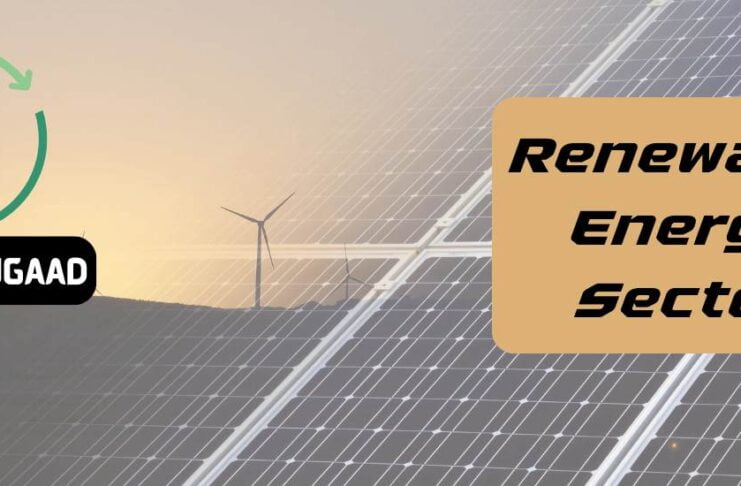India is the fastest growing economy because of this, the amount of energy the country uses is increasing quickly. India used approximately 1.844 trillion kilowatt-hours of energy of all sources including Renewable and Non Renewable sources. But, India is also determined to use more renewable energy sources. In the last 8.5 years, India has boosted its non-fossil fuel power by a huge 396%, reaching over 179.57 GW. This includes hydro and nuclear energy. It’s now 42% of the country’s total power.
Solar power has been a big success story, shooting up by 30 times in the last nine years to hit 74.30 GW. India’s got huge solar potential, estimated at 748 GWp by the National Institute of Solar Energy. Renewable energy capacity, including big hydro projects, has nearly doubled since 2014, showing India’s serious about moving away from fossil fuels. This shift is not only good for the environment but also sets India up for a brighter, cleaner energy future.
Profit from the growth of the renewable energy market

The Renewable Energy market in India reached a value of US$ 22 Billion IN 2023. Experts predict that it will continue to grow at a rate of 7.13% annually from 2024 to 2028. This growth is fueled by various factors that are contributing to the expansion of renewable energy in the country.
The renewable energy market in India has tremendous potential for growth, thanks to several favorable factors. The Indian government’s support for the renewable energy sector has led to beneficial policies, like tax breaks and subsidies, attracting more investors. As the cost of fossil fuels rises, renewable energy becomes increasingly competitive. Moreover, with the growing demand for electricity in India, renewable sources offer a clean and sustainable solution without adding to greenhouse gas emissions. Technological advancements have made renewable energy more efficient and affordable, further driving its adoption.
The Indian renewable energy market is quite diverse, with various technologies in use. Solar power stands as the most popular, with solar plants being set up all over the country and rooftop solar systems gaining popularity. Wind power follows closely, with wind farms established in several states for both domestic and industrial electricity generation. Hydro power, a traditional renewaIndible energy source, still plays a significant role in India’s energy mix, with hydro power plants contributing substantially to the grid. Additionally, biomass, derived from organic matter, is being utilized to generate electricity for various purposes, adding to the nation’s renewable energy efforts.
India says it will go net zero by 2070
India is the third-largest consumer of energy worldwide. When it comes to renewable energy, India ranks fourth globally in installed capacity, including large hydro projects. It holds the same position in both wind and solar power capacity.
In Conference Of Parties (COP-26) held in United Kingdom (U.K.) India promised to the world that it will be Carbon Neutral Country by 2070 so it is very important to focus on Renewable Energy sector to fulfill his recruitment. India will meet 50% of its energy recruitment from Renewable Energy sources by 2030 that brings lots of investment in Renewable Energy Sectors.
India has big plans to make its economy greener. By 2030, it wants to cut how much carbon it produces by 45%. To do this, it’s aiming to have a whopping 500 gigawatts of renewable energy by 2030. India is also getting serious about solar power. It has approved the building of 50 solar parks, which will generate a total of 37.49 gigawatts. And for wind energy, India is eyeing offshore sites to build wind farms, with a goal of reaching 30 gigawatts by 2030. One exciting part of this plan is to make five million tonnes of green hydrogen by 2030. This will be supported by setting up 125 gigawatts of renewable energy systems.
India make International Solar Alliance (ISA) to create sustainable world
The International Solar Alliance (ISA) is a group of more than 100 countries that work together to encourage the use of solar energy. Their goal is to have 1,000 GW by 2030. India and France started the ISA in 2015, and its headquarters are in Gurugram, India. The alliance aims to promote clean and sustainable solar energy on a global scale.
FDI(Foreign Direct Investment) In Green Energy Sector:
Foreign Direct Investment (FDI) up to 100% is permitted for renewable energy generation and distribution projects through the automatic route, provided it complies with the provisions of The Electricity Act 2003.
Government commitments:
India has set ambitious environmental goals, including reducing its projected carbon emissions by 1 billion tonnes by 2030, decreasing the carbon intensity of its economy by less than 45% within this decade, and ultimately achieving net-zero carbon emissions by 2070.
To achieve these objectives, several initiatives have been proposed:
- Solar Cities and Parks:
India plans to establish solar cities and 59 solar parks with a combined capacity of 40 gigawatts (GW) across the country. Additionally, there is a focus on promoting Floating PV Projects. - National Green Hydrogen Mission:
The Union Cabinet has approved the National Green Hydrogen Mission with an initial budget of INR 19,744 crores. This mission includes funding for the SIGHT program, pilot projects, research and development, and other mission components, aiming to produce green hydrogen and ammonia. - Offshore Wind Energy:
India has set medium and long-term targets for offshore wind power capacity. The goal is to achieve an impressive 30 GW by 2030. - Wind-Solar Hybrid Policy:
A national policy was introduced in 2018 to encourage the integration of wind and solar power through grid-connected hybrid systems. This approach helps address the intermittency challenges of renewables and enhances grid stability. It allows flexibility in the balance of wind and solar components in hybrid projects, with one resource accounting for at least 25% of the rated power capacity of the other. - AatmaNirbhar Bharat:
Under the AatmaNirbhar Bharat initiative, India has introduced a Production-Linked Incentive (PLI) scheme for Solar PV manufacturing with a financial outlay of INR 24,000 crores. Additionally, there has been an imposition of Basic Customs Duty of 25% on Solar Cells and 40% on Solar PV Modules, effective from April 1, 2022.
These efforts underscore India’s commitment to promoting clean energy, reducing carbon emissions, and fostering self-reliance in the renewable energy sector.
Production Linked Incentive (PLI) Scheme for the Green Energy Sector: INR 24,000 cr Scheme Outlay
The Union Cabinet, led by Prime Minister Shri Narendra Modi, has given the green light to implement the Production-Linked Incentive (PLI) Scheme for High-Efficiency Solar Photovoltaic (PV) Modules. This initiative is designed to bolster India’s manufacturing capabilities and promote exports as part of the Aatmanirbhar Bharat (self-reliant India) campaign.
Here are the key program details:
High-Efficiency Solar PV Modules Program:
- Tranche 1: INR 4,500 crores (approximately US$550 million).
- Tranche 2: INR 19,500 crores (approximately US$2.37 billion). The second phase, launched on 2022, aims to establish an annual manufacturing capacity of 65 gigawatts (GW).
National Green Hydrogen Mission:
- An allocation of INR 19,744 crores (approximately US$2.4 billion).
- The mission targets the production of 5 million metric tons (MMT) of annual green hydrogen and ammonia by 2030.
Investors can submit their bids to qualify for incentives. This initiative is expected to create direct employment opportunities for around 30,000 individuals and indirect employment for approximately 120,000 people. It also aims to reduce annual imports by about INR 17,500 crores and foster research and development efforts to enhance the efficiency of solar PV modules.
Sectors to Invest in Green Project :
There are a number of ways to invest in the renewable energy sector in India. Here are a few of the most popular Sectors.
Investing in the renewable energy sector can be as simple as buying shares of companies that are actively involved in developing, manufacturing, or distributing renewable energy technologies. By purchasing stocks of such companies, you become a direct investor in the sector and have the potential to benefit from its growth.
Here are some of the top three renewable energy stocks in India that you may consider for investment:
- Adani Green Energy: One of the biggest solar power developers in India. Read full information here of Adani Green Energy
- Renewable Energy India Limited: Engaged in developing and operating wind and solar power projects.
- Greenko Group: A leading developer of renewable energy projects in India and other countries.
List Of Renewable Energy Stocks
These companies are actively contributing to the growth of renewable energy in India and have shown potential for investors seeking opportunities in the clean energy sector.
Investing inRenewable Energy ETFs: ETFs are like mutual funds but trade on the stock exchange. They offer liquidity, meaning you can sell your shares quickly if needed. There are ETFs that focus on clean energy, tracking the performance of global clean energy or solar stocks.
Investing in Renewable Energy Mutual Funds: This is an indirect approach to invest in the sector. Mutual funds spread your investment across various renewable energy companies, reducing risk, especially if you are new to investing in clean energy.
Investing in Renewable Energy Projects: This is a riskier and less liquid option but can be rewarding. You can directly fund renewable energy projects or buy shares in project development companies, supporting the growth of clean energy initiatives.
Read Here- Help Desk Of Government Of India Official Portal For Renewable Energy Sector
What government initiatives support renewable energy investments?
The Indian government has introduced various initiatives, including the Production Linked Incentive (PLI) Scheme with a INR 24,000 crore outlay, the National Green Hydrogen Mission, and targets for solar cities, parks, and offshore wind energy. These initiatives aim to promote clean energy, reduce carbon emissions, and enhance self-reliance in the renewable energy sector.
How does Foreign Direct Investment (FDI) work in the green energy sector in India?
FDI up to 100% is permitted for renewable energy generation and distribution projects through the automatic route, aligning with the provisions of The Electricity Act 2003. This opens opportunities for international investors to actively participate in India’s renewable energy market.
How does India rank globally in renewable energy?
Third-largest energy consumer, fourth in renewable capacity; aiming for 500 GW non-fossil fuel energy by 2030.
What government initiatives support renewable energy investments?
Production Linked Incentive (PLI) Scheme, National Green Hydrogen Mission, and targets for solar cities and offshore wind energy.







